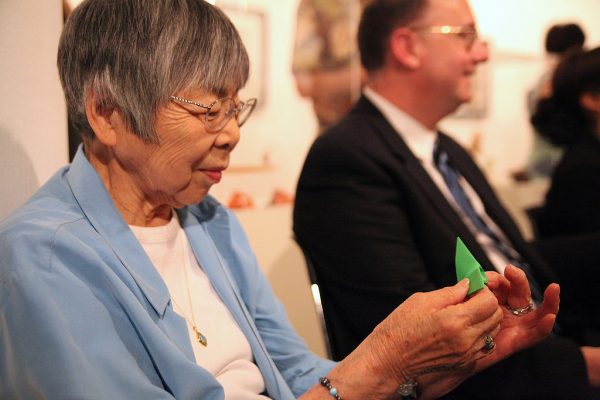Living in a modern world students have so much more at their fingertips that without thinking they can transform a simple sheet of paper into a three dimensional origami art work that has been an age old tradition in the Japanese culture for many generations.
[HTML1]
Curators June Sakamoto and Vicky Mihara Avery have brought this unfamiliar art form to students with the opening reception of “Movement in paper: the Evolving Form of Origami” this past Thursday, May 1.
“Most art requires a lot of equipment, like with painting you need all the different colored paint, more than one brush and time. But with origami anyone can do it with a single sheet of paper, anyplace, anywhere and anytime and in minutes you have completed a project,” said Sakamoto, commenting on the unique simpleness of the art.
In passing, curator Carolyn Ho spoke with Jon Funabiki, professor in the journalism department after his show in 2013, titled “Voices from Japan: Tanka — After the Tsunami.” She told him she wanted to put on an origami show because it was something she personally enjoyed. A year later, the show is now reality.
Illuminating the white walls are many three-dimensional paper cranes, as well as various glass cases displaying different types of origami, from sea animals, wildlife and dinosaurs.
With the light live jazz music playing in the background and Asian cuisine for all to enjoy, guests were invited to participate in making paper cranes that artists Martin Sejer Andersen, Goran Konjevod and Bernie Peyton demonstrated.
Later, a screening of “Between the Folds”, a film by Vanessa Gould, featured many different origami craftsmen and Akira Yoshizawa, an artist who transformed modern origami into real, breathtaking sculptures that do not resemble paper in the slightest.
The curators thanked the small gathering and spoke about the biggest misconception that people can have on origami. “People think of it as child’s play, so having exhibitions like this helps changes people’s perception. People get blown away with what can be accomplished,” said Avery.

Kevin Umana, a senior fine arts and art history major, said, “There’s different ways to use the mediums of paper, instead of printmaking it can be used for a different purpose. The inside can look simple and the outside eccentric.”
“You’re limited to the characteristic of the paper. It’s flat and you’re trying to make it three dimensional object out of a two dimensional paper,” said Sakamoto. Mathematicians can fall into this art form as well because of the technical folding that math equations can play into them creating a simple crane into a complex crane and not realize the one sheet it took to get there.
The exhibit will be on display until July 15 in the Student Center Art Gallery.






